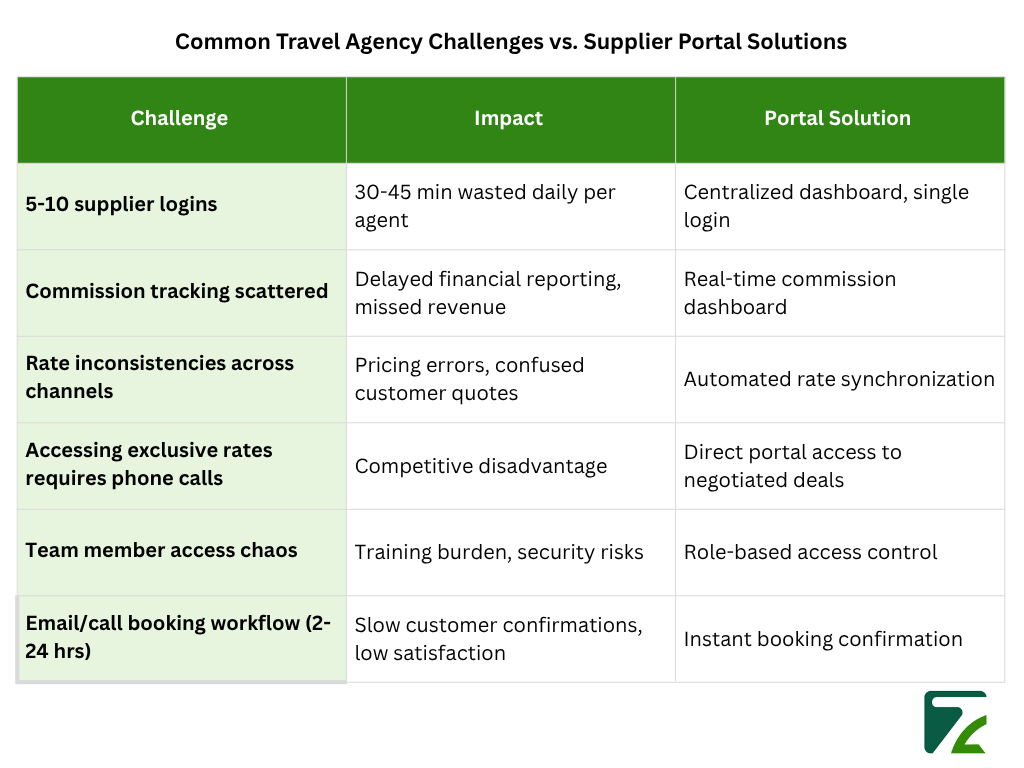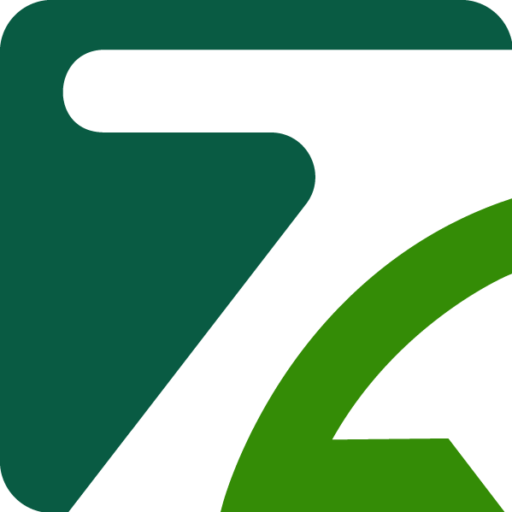Multiple supplier logins are being used , TBO for hotels, Travelport for flights and different systems yet again to book a car or an activity ; resulting in operational chaos.” 72% of travel was booked online in Q1 2025, but many agencies still maintain supplier relationships through disparate and manual based processes, which costs them time consuming 30-45 minutes per agent each day.
A supplier portal addresses this: a common interface that links agents to multiple suppliers for live bookings, commission reconciliation, inventory management all from one dashboard.
In this guide, we lay out what supplier portals are and why they matter, and how you can effectively adopt one.
A supplier portal is a kind of internet platform that integrates travel agents directly with suppliers (such as hotels, airlines, tour operators, car rentals, activities), allowing one to manage bookings, pricing, commissions and inventory through the same interface.
Differentiator: Travel supplier portals are unique from procurement-based (invoicing and payment processing) portals because they’re designed for travel’s specific requirements real-time booking processing/dynamic pricing/commission tracking/private rate access.
Actual Example: Log in to TBO and access global Hotel inventory, Airlines, Holiday Packages and Transfers on one Portal without multiple booking URLs.
Travel agencies face specific operational challenges that supplier portals directly solve:

Impact on Revenue: As per Agency Auto 2025 Commission Management Study, supplier portals enable the agencies:
– To Reduce supplier management time per agent by 40-50%
– Improve markup control causing a 15-20% increase profit margins.)
– Achieve booking accuracy of over 98% versus the manual process at about 85%.
For a 10-agent business with 15 suppliers, this equates to over 200 hours saved per year or effectively an employee’s worth of time.
When evaluating portals, prioritize:
Inventory & Commissions in Real Time Live availability and earnings dashboards: what’s bookable-how much do I earn from each supplier?
Markup flexible management Different markups can be applied to each supplier or sub-agent, to optimize and expand together.
Multi Currency & Multi Language Essential for global agencies; TBO is designed for service in local currency providing connectivity with 24 X 7 customer support.
Sub-Agent Access Control Role-based permissions enable team members to access only what they need, while there is still central visibility vital for scaling without madness.
API Integrations Integrate with CRM (Salesforce, HubSpot, Zoho), accounting packages (QuickBooks, Xero) and booking engines (Sabre Amadeus) to save you time on re keying data.
Performance analytics track booking trends, supplier performance with data and revenue insight decisions.
24/7 Support Top portals provide you with immediate support in different languages. My Travelport addresses this by offering eLearning training and excellent account management.
Challenge: Juggling and sharing logins for 10+ high-end hotel chains (such as Four Seasons, Mandarin Oriental, Aman) and manually tracking commissions.
Portal Solution: One dashboard showing real time rates, exclusive suite inventory and commission levels all at a glance. Automated Booking Confirmations instead of manual email delays.
Outcome: 35% faster bookings, 20% rise in commissions because they’re visible, happy clients.
Challenge: 5 agents + 50+ sub-agent partners logging into 15 different supplier sites; rates are all over the map, commission messages everywhere.
Portal Solution: You have control of this rate level; your team members can see their own rates. Centralized booking and clear commission dashboards.
Outcome: Uniform pricing for all subordinate agents, 40% saving in reconciliation time.
Challenge: 8 offices booking independently, maintaining rate parity impossible, clients seeing different rates based on where booking took place.
Portal Solution: One Centralized Portal with Negotiated Corporate Rates Set Once. All Offices Kept Up to date, No Overbooking; all offices have the same pricing.
Outcome: One-rate system (transparent to clients), 45% quicker bookings, graphically correct cost allocation
Travel agents often ask: Do I need both? Yes, they serve different purposes:

Practical Use: Use Sabre/Amadeus for flight bookings while simultaneously using TBO’s supplier portal for better hotel rates and exclusive properties.
Maintain Rate Parity Analyze Rates periodically from all portals. If the rate of one supplier is much higher than the other, increase its priority. Leverage portal reporting to identify discrepancies.
Supplier’s Performance Keep an eye on how they are doing on booking successes, price competitiveness, response time and satisfied customers. Adjust allocation accordingly.
Implement Hotel Booking Reconfirmation (After Portal) Once a booking was made in the initial portal, confirmations need to be delivered as expected to hotels. 1 in 4 hotels deal with booking challenges in their first year of business, typically because of miscommunication between OTA systems and Property Management Systems.
Automated reconfirmation (via portal features or its own dedicated tools) 48-72 hours in advance can head off discrepancies before guests arrive at a hotel and cancel the booking, which eliminates “walking” and expensive rebooking. Learn more about reconfirmation strategies.
Standardize Team Training Develop model reference cards per supplier. They assigned a portal champion for every supplier to fix the problems and assist the team.
Data Integrations Automated Integrate via API for automated availability syncing, connect your CRM to capture bookings and fire alerts for big rate changes.
Challenge 1: Integration Complexity Your legacy CRM was never designed for modern APIs.
Solution: Select portals with strong API documentation. Leverage (middleware like Zapier, n8n) for the less complex integrations. For professional services if you can afford it.
Challenge 2: Learning Curve. Your team is familiar with the old GDS. The new portal is strange at first.
Solution: Two weeks of training. Run parallel systems initially. Have a dedicated support contact. Make sure to create documentation for your own unique workflow.
Challenge 3: ROI Calculating how much does it really cost?
Solution: Determine reduced hours ($ saved per hour) = Hours previously used × Average value for the grade. Compare rises in track commission and improvement in booking accuracy (less errors = fewer rebooking charges). Most agencies would return the investment in 90-180 days.
Costs are highly variable, depending on the model and size of agency:
SaaS Model (Most Common):
Subscription Fee: $50-500/month bases on volume of bookings and features
Per-Booking Commission: 0-2% per transaction depending on supplier pattern is
Setup Costs: $0-$500 in most cases

Example ROI: A 10-agent agency spending 40 hours/week managing suppliers at a cost of $25/hour = $1,000 saved per week. Monthly savings: $4,000. A $300/month portal can pay for itself in 2-3 days.
Popular Integrations Pricing:
1. TBO: Tiered model; Contact for pricing details
2. Travelport (My Travelport): Enterprise pricing; GDS integration included
3. Agency Auto: Low price-range model; $100-300/month is standard rate for small agencies
4. Safari Portal: Price range starting from $199-$399 per month based on the plan
Weeks 1–2: Decide on portals, ask for demos and negotiate terms
Weeks 3-4: Create account, add team members, set up permissions
Weeks 5-6: Integrate with CRM/Accounting systems, check on the data flow
Week 8: Start with low volume trial bookings, confirm is working fine
Weeks 9- 12: Investigate performance, polish your approach, scale!
The supplier portal, once optional for the competitive travel agents, is finally a must-have. With one point of access for suppliers and automated tracking of commissions through real time bookings, portals provide tangible savings in terms of time and profitability.
The trick is to select the right portal for your agency’s unique needs (see pricing guide above), set it up correctly with detailed training and constantly track performance.
Whoever owns the supplier portal management wins: faster bookings, more margins, better customer satisfaction and operational efficiency at scale.
For additional resources on optimizing your travel operations, explore our guide on hotel booking reconfirmation systems and travel agency reconfirmation best practices on Zeal Connect.
A supplier portal is an online platform that lets travel agents access, book, and manage multiple hotel, flight, and activity suppliers from one dashboard. It simplifies supplier management, centralizes rates and commissions, and speeds up bookings replacing the old system of juggling numerous supplier logins and manual spreadsheets.
A supplier portal is focused on direct access to hotels, activities, and non-air suppliers with real-time rates and commissions, while a GDS specializes in flight inventory and connects agents to airline networks. Most agencies use both: supplier portals for hotels and tours, and GDSs for flights.
Supplier portal costs vary, but most charge a setup fee ($0–$500), a monthly subscription ($50–$500 based on agency size), and sometimes a per-booking commission of 0–2%. Many platforms offer pricing tiers for small, mid-sized, and large agencies.
Travel agents most often face login issues, booking confirmation errors, and trouble syncing data with their CRM. Troubleshooting involves contacting portal support, double-checking credentials, ensuring integrations are updated, and using built-in to help resources for common workflows.
Many supplier portals offer built-in reconfirmation tools that re-check bookings with hotels before guest arrival, reducing errors and no-shows. Agents can set up automated reminders or use portal integrations to trigger reconfirmation messages and verify details, streamlining the whole process.

Travel Automation Expert